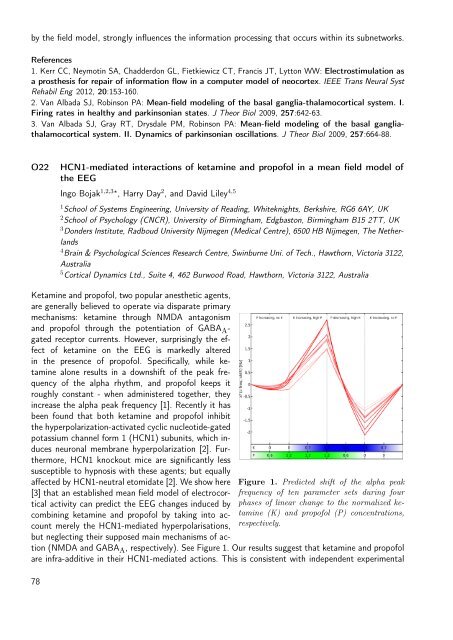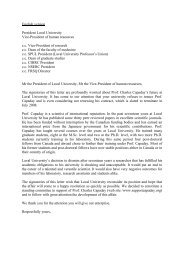Untitled - Laboratory of Neurophysics and Physiology
Untitled - Laboratory of Neurophysics and Physiology
Untitled - Laboratory of Neurophysics and Physiology
You also want an ePaper? Increase the reach of your titles
YUMPU automatically turns print PDFs into web optimized ePapers that Google loves.
y the field model, strongly influences the information processing that occurs within its subnetworks.<br />
References<br />
1. Kerr CC, Neymotin SA, Chadderdon GL, Fietkiewicz CT, Francis JT, Lytton WW: Electrostimulation as<br />
a prosthesis for repair <strong>of</strong> information flow in a computer model <strong>of</strong> neocortex. IEEE Trans Neural Syst<br />
Rehabil Eng 2012, 20:153-160.<br />
2. Van Albada SJ, Robinson PA: Mean-field modeling <strong>of</strong> the basal ganglia-thalamocortical system. I.<br />
Firing rates in healthy <strong>and</strong> parkinsonian states. J Theor Biol 2009, 257:642-63.<br />
3. Van Albada SJ, Gray RT, Drysdale PM, Robinson PA: Mean-field modeling <strong>of</strong> the basal gangliathalamocortical<br />
system. II. Dynamics <strong>of</strong> parkinsonian oscillations. J Theor Biol 2009, 257:664-88.<br />
O22<br />
HCN1-mediated interactions <strong>of</strong> ketamine <strong>and</strong> prop<strong>of</strong>ol in a mean field model <strong>of</strong><br />
the EEG<br />
Ingo Bojak 1,2,3⋆ , Harry Day 2 , <strong>and</strong> David Liley 4,5<br />
1 School <strong>of</strong> Systems Engineering, University <strong>of</strong> Reading, Whiteknights, Berkshire, RG6 6AY, UK<br />
2 School <strong>of</strong> Psychology (CNCR), University <strong>of</strong> Birmingham, Edgbaston, Birmingham B15 2TT, UK<br />
3 Donders Institute, Radboud University Nijmegen (Medical Centre), 6500 HB Nijmegen, The Netherl<strong>and</strong>s<br />
4 Brain & Psychological Sciences Research Centre, Swinburne Uni. <strong>of</strong> Tech., Hawthorn, Victoria 3122,<br />
Australia<br />
5 Cortical Dynamics Ltd., Suite 4, 462 Burwood Road, Hawthorn, Victoria 3122, Australia<br />
Figure 1. Predicted shift <strong>of</strong> the alpha peak<br />
frequency <strong>of</strong> ten parameter sets during four<br />
phases <strong>of</strong> linear change to the normalized ketamine<br />
(K) <strong>and</strong> prop<strong>of</strong>ol (P) concentrations,<br />
respectively.<br />
Ketamine <strong>and</strong> prop<strong>of</strong>ol, two popular anesthetic agents,<br />
are generally believed to operate via disparate primary<br />
mechanisms: ketamine through NMDA antagonism<br />
<strong>and</strong> prop<strong>of</strong>ol through the potentiation <strong>of</strong> GABA A -<br />
gated receptor currents. However, surprisingly the effect<br />
<strong>of</strong> ketamine on the EEG is markedly altered<br />
in the presence <strong>of</strong> prop<strong>of</strong>ol. Specifically, while ketamine<br />
alone results in a downshift <strong>of</strong> the peak frequency<br />
<strong>of</strong> the alpha rhythm, <strong>and</strong> prop<strong>of</strong>ol keeps it<br />
roughly constant - when administered together, they<br />
increase the alpha peak frequency [1]. Recently it has<br />
been found that both ketamine <strong>and</strong> prop<strong>of</strong>ol inhibit<br />
the hyperpolarization-activated cyclic nucleotide-gated<br />
potassium channel form 1 (HCN1) subunits, which induces<br />
neuronal membrane hyperpolarization [2]. Furthermore,<br />
HCN1 knockout mice are significantly less<br />
susceptible to hypnosis with these agents; but equally<br />
affected by HCN1-neutral etomidate [2]. We show here<br />
[3] that an established mean field model <strong>of</strong> electrocortical<br />
activity can predict the EEG changes induced by<br />
combining ketamine <strong>and</strong> prop<strong>of</strong>ol by taking into account<br />
merely the HCN1-mediated hyperpolarisations,<br />
but neglecting their supposed main mechanisms <strong>of</strong> action<br />
(NMDA <strong>and</strong> GABA A , respectively). See Figure 1. Our results suggest that ketamine <strong>and</strong> prop<strong>of</strong>ol<br />
are infra-additive in their HCN1-mediated actions. This is consistent with independent experimental<br />
78



